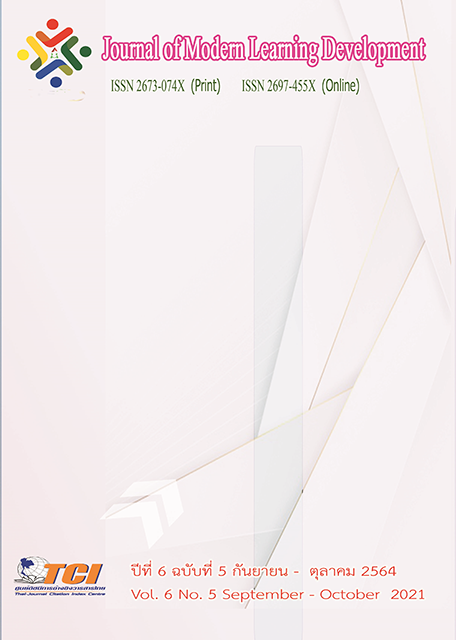The Quality on Morality Teaching of Buddhist Monks in Primary Schools of Non Sang District in Nongbua Lamphu Province
Main Article Content
Abstract
The objectives of this research were: 1) to study the teaching and learning management of monks who teach morality in elementary schools in Non-Sang District, Nongbua Lamphu Province; 2) to study the teaching quality of monks teaching morality in elementary schools in Non-Sang District, Nongbua Lamphu Province. The study was carried out by means qualitative research. The data collection was conducted from studying documents and in-depth interviews.
The results of the research were as follows: teaching quality; monks teaching morality Non-Sang District, Nongbua Lamphu Province.
The conditions of teaching and learning of monks who teach morality in elementary schools in Non Sang District, Nongbua Lamphu Province: 1) the assigned teaching and learning are organized in accordance with the Buddhist learning subjects in the basic education curriculum; 2) curriculum content and learning management in teaching Buddhism are appropriate for students; 3) media and teaching materials are adequate and suitable for learning management; 4) evaluation, monks have various measures but do not have a measure of results related to the grading of students as it is a measure of results only during study time; 5) promoting morality, administrators and teachers recognize the importance of promoting and supporting moral teaching in schools as appropriate.
Teaching quality of monks teaching morality in primary schools in Non Sang District, Nongbua Lamphu province related to the quality in four aspects: 1) the use of teaching materials, most monks do not use modern teaching materials and lack knowledge and ability in using teaching materials; 2) creating an environment for teaching, there is a suitable environment that facilitates the teaching and learning; 3) teaching operations, monks teach morals in a variety of teaching methods but still lack the knowledge and ability to stimulate students' interest during teaching practice; 4) measurement and evaluation, monks still lack knowledge of measurement and evaluation procedures and understanding of score analysis.
Article Details
References
กรมการศาสนา กระทรวงวัฒนธรรม.(2550). คู่มือการดําเนินงานตามโครงการพระสอนศีลธรรมในโรงเรียน ปีงบประมาณ 2550. กรุงเทพมหานคร: โรงพิมพ์ชุมนุมสหกรณ์การเกษตรแห่งประเทศไทย จํากัด.
กฤษณา คิดดี . (2547). การพัฒนารูปแบบการประเมินการจัดการเรียนการสอนที่เน้นผู้เรียนเป็นสำคัญ.กรุงเทพมหานคร: จุฬาลงกรณ์มหาวิทยาลัย.
กองทุนไตรรัตนานุภาพ ศูนย์ศูนย์ส่งเสริมพระพุทธศาสนาแห่งประเทศไทย. (2549). ฝันให้ไกล ไปให้ถึง. กรุงเทพมหานคร: บริษัท แปดสิบเจ็ด จํากัด.
ณัฎฐิกา ลิ้มเฉลิม. (2554). การศึกษาแนวทางการจัดการศึกษาสามรูปแบบในสถานศึกษา. ปริญญานิพนธ์. กศ.ด (การบริหารการศึกษา). บัณฑิตวิทยาลัย: มหาวิทยาลัยศรีนคริทรวิโรฒ.
บัณฑิต ฉัตรวิโรจน์ . (2550). การพัฒนารูปแบบการจัดการเรียนการสอนแบบการจัดการความรู้เพื่อเสริมสร้างสมรรถนะการสอนของนักศึกษาครู. กรุงเทพมหานคร: จุฬาลงกรณ์มหาวิทยาลัย.
ปกรณ์ บุญสำราญ. (2532). การศึกษากลวิธีสอนจริยศึกษาของครูผู้สอนจริยศึกษาดีเด่นในโรงเรียนประถมศึกษาจังหวัดลำปาง . วิทยานิพนธ์. บัณฑิตวิทยาลัย: มหาวิทยาลัยเชียงใหม่.
พระมหาวรพงษ์วรเมธี (บุญปน). (2544). ปัญหาการเรียนการสอนวิชาจริยศึกษาชั้นประถมศึกษาปีที่ 5-6 ในโรงเรียนสังกัดเทศบาลนครเชียงใหม่. วิทยานิพนธ์พุทธศาสตรมหาบัณฑิต สาขาวิชา พระพุทธศาสนา. บัณฑิตวิทยาลัย: มหาวิทยาลัยมหาจุฬาลงกรณราชวิทยาลัย.


